Japan March travel: seasonal highlights, themes and attractions
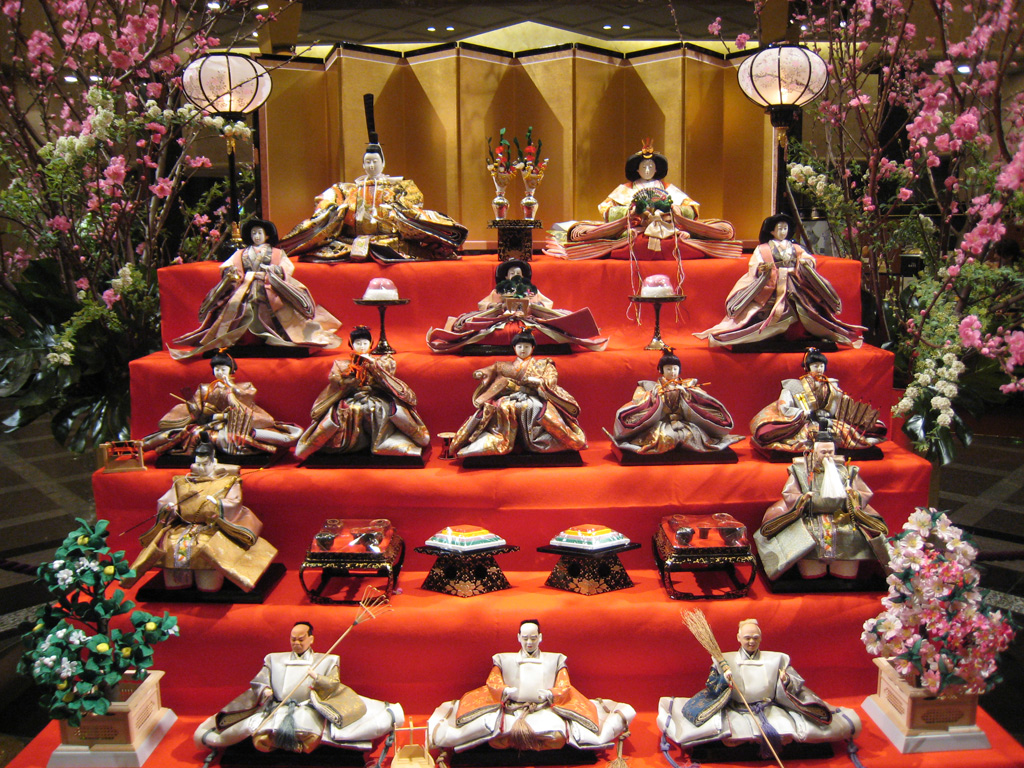
The month of March for travel in Japan is the first month of spring in the modern Japanese calendar: the first half of the month is low season. However, over the last 30 years, climate change has “accelerated” spring. And now, the last 10 days of March are peak season for domestic Japanese travelers, which means Kyoto, Nara and top weekend destinations near Tokyo (Hakone-Mount Fuji, Kamakura, Nikko) are extremely crowded and this means good advanced planning is necessary for peak March season travel in Japan.
The weather in March across the east-west main island of Honshu is typically chilly still in the day time and night temperatures can get near freezing. Average Kyoto and Tokyo March temperatures: Average high: 13 C / 56 F. Average low: 4 C / 39 F. However, the last 10 days of March are warmer and on good sunny days the highs can reach 18 C / 65 H. So wear clothing in shell layers with an outer wind blocking material. The changing weather in March means you can experience the kasumi mists in the mornings which are especially stunning in historical settings like Kyoto and the Mount Fuji area . . . March is also known for the “first” rains of spring known as harusame (spring rain).
In the Japanese tea ceremony, the month of March has been poetically captured with “goma” associations that capture the essence of each 10-day period: early March, mid March, late March. These key words and themes that have been classically repeated in Japan for more than 1,200 years. The March goma key words can help you “imagine” what to expect when you travel in Japan in that month. Early March seasonal themes: late plum blossoms, paper lamp shades, paper lanterns, “things” related to the Hina Matsuri Doll Festival (March 3rd), tsukushi horsetail appearing, spring field planting scenes. Mid March seasonal themes: Haru same or spring rain; March 15 is the memorial service for the death of Buddha and huge scrolls on display; Late March seasonal themes: the Buddhist higan spring equinox cemetery services (March 17-24), early cherry blossoms in key locations; the anniversary of Sen no Rikyu, founder of the Japanese tea ceremony (March 28).
March is also known as the month for gathering shells and using shells in various traditional motifs and events like the Hina Matsuri doll festival in early March.
- Japan March travel food highlights
- Japan March travel tree and flower highlights
- Japan March travel festival highlights
- March Equinox & Japanese Graveyards: This world and the next
- March interview: The Katsura Family: Famous doll makers
Content by Ian Martin Ropke, owner of Your Japan Private Tours (est. 1990). I have been planning, designing, and making custom Japan private tours on all five Japanese islands since the early 1990s. I work closely with Japan private tour clients and have worked for all kinds of families, companies, and individuals since 1990. Clients find me mostly via organic search, and I advertise my custom Japan private tours & travel services on www.japan-guide.com, which has the best all-Japan English content & maps in Japan! If you are going to Japan and you understand the advantages of private travel, consider my services for your next trip. And thank you for reading my content. I, Ian Martin Ropke (unique on Google Search), am also a serious nonfiction and fiction writer, a startup founder (NexussPlus.com), and a spiritual wood sculptor. Learn more!
Japan March travel food highlights
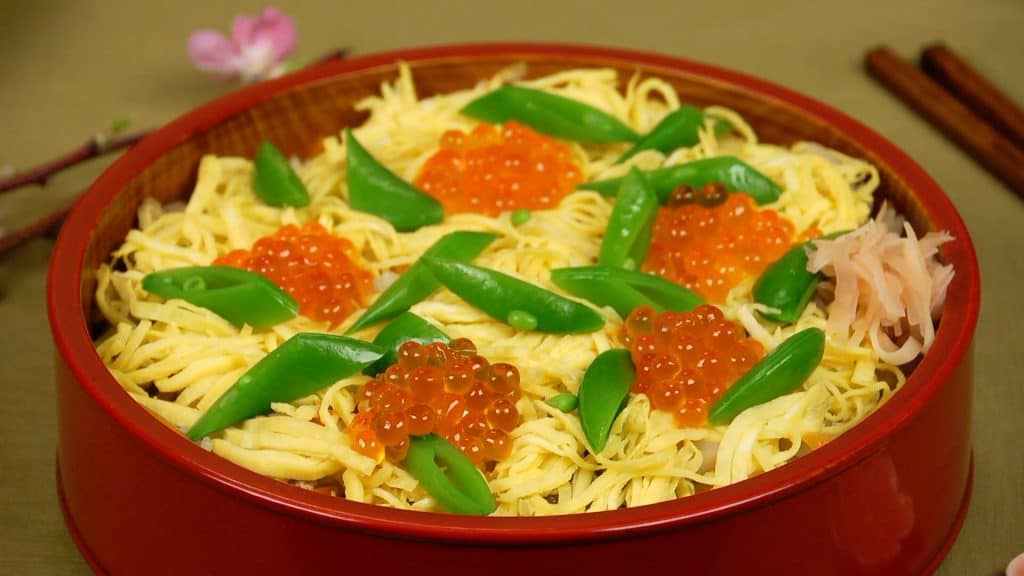
The rush of spring rising in March leads to new cuisine ingredients that range from early bamboo shoots (mostly from warmer Kyushu) and sansai “mountain vegetables” to excellent seafoods and special old desserts related to Doll’s Day.
Sansai mountain vegetables: In the Japanese hills and lower mountain slopes March is the beginning of sansai mountain vegetable season (lasting until about mid-May or so). These unique natural spring vegetables (complemented by 7 grasses and flowers in autumn) pop up and are harvested for high-class kaiseki meals and also for use in local izakaya restaurants. Sansho Japanese pepper: young kinome sansho leaves are amazing and used to add a strong sense of flavor to miso soups, with young bamboo shoot dishes and various seasonal rice dishes. New yomogi mugwort leaves are are boiled, ground, and mixed with mochi rice dough to make yomogi mochi. When dried the leaves are commonly used to both scent and improve the bath water in sentos, onsens and in the at home ofuro. Seri Japanese watercress is finely chopped and sprinkled on miso soup or rice dishes. Tampopo dandelion flowers are used for tempura or mixed with walnuts (or peanuts or sesame) and flavored with a bit of soy sauce, sugar and sometimes mustard. Mitsuba trefoil leaves are another mountain vegetable that is used as a garnish for miso soup and traditional rice dishes. Nanohana rape blossom stalks have thick stalks and can be tempuraed or blanched and then flavored with sesame and soy sauce. Warabi bracken fern fiddleheads are something that some foreigners are familiar with at home and in Japan these fresh fiddleheads are equally prized and served in various forms.
Seasonal seafood picks: The Japanese seafood catch of March is still great (as the cold months yield the best fish with few exceptions). So, in March you can look forward to excellent fish cuisine wherever you go. Favorites include tai sea bream, sazae turbanshells, sawara Japanese Spanish mackerel, hotoruika firefly squid and hamaguri clams.
March traditional Japanese sweets: March, largely because of Girl’s Day, is associated with all kinds of sweets and snacks some are even warm! Sakura mochi: Cherry mochi rice cakes are pink and popular in all the months of spring in Japan. They are made of pink-colored mochi stuffed with red-bean paste, wrapped in a pickled cherry leaf. They are sold widely at food stalls and even in convenience stores. Just look for the pink! Taiyaki fish cakes: These fish cakes are a big favorite with foreigners. They are served warm (with either a white custard or a bean paste filling). Big hothouse strawberries: The clever farmers of Kyushu around Fukuoka have been growing huge hothouse strawberries in late winter-early spring since WWII. Some remain in Japan but most have been snapped up by 5-star hotels across southeast Asia. In Japan you can find them in specialty fruit shops and also in ichigo daifuku soft mochi cakes. Hishimochi rice cakes: Hishimochi are diamond-shaped rice cakes usually made of white, pink and green layers. They originated as a Shinto New Year offering to the gods in the Heian period. But overtime they became associated with Girl’s Day or Doll’s Day (March 3).
Japan March travel tree and flower highlights
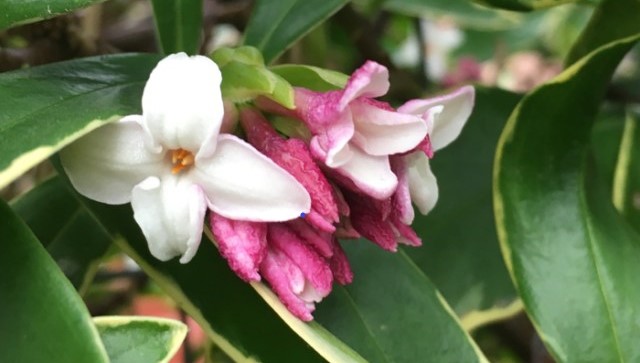
In March in Japan it gets warmer day by day and the sense of spring increases dramatically. In my experience no country on earth has a stronger feeling of early spring than Japan. The earth seemingly erupts with a burst of energy that pulses through plants, trees and creatures big and small.
March is a transition month for flowers in Japan, a transition from late ume plum blossoms to early sakura cherry blossoms. Late plum blossoms can be experienced in March at higher elevations and further up north (Sendai, Aomori, Hokkaido). Early cherry blossoms are increasingly common due to climate change and nowadays you can expect to see sakura cherry blossoms in many coastal (low elevation) areas between Tokyo and Kyoto and also in key areas in beautiful Kyushu island (Fukuoka).
Peach blossoms are also a March symbol central to Girl’s Day or Hina Matsuri (early March). Many traditional families with daughters place flowering bonsai peach trees next to the doll arrangements (see below) to “protect” their girls and ensure their good fortune in coming years. Peach blossoms are said to have to power to ward off evil spirits. Peach blossoms range in color from white to bright pink.
The other flowers to look for in March across much of Japan are: 1. The Japanese daphne (chinchoge): This hardy bush is best thought of as the Japanese gardenia: the flowers are thick-petaled and give off a heady scent. 2. The cascading snow willow (yuki yanagi): Seeing these bushes in flower when there is no breeze or in the wind is amazing. The abundant tiny flowers crowd around long wavy leafy branches that bob gracefully in the slightest breeze. 3. Shunran (“the noble orchid”): These orchids are not terribly easy to find for a foreign tourist but you can. They appear in lower elevation deciduous forests but you can also find them in the large imperial gardens and estates of Tokyo (Edo) and Kyoto (Miyako). 4. Kobushi magnolia trees (Magnolia kobus): Japan’s magnolia trees (ranging from 5-18 meters in height) and their powerful large flowers (6-10 cm across!) on branches with zero leaves is a fine sight and they can be found equally in garden estates at temples and also in private old garden estates. Just ask around. 5. Yanagi willow first leaves: Towards the end of March you can look forward to the exquisite sight of the first jewel green yanagi willow leaves decorating long weeping branches swaying in the breezes of spring rising.
- Japan March travel food highlights
- Japan March travel tree and flower highlights
- Japan March travel festival highlights
- March Equinox & Japanese Graveyards: This world and the next
- March interview: The Katsura Family: Famous doll makers
Japan March travel festival highlights
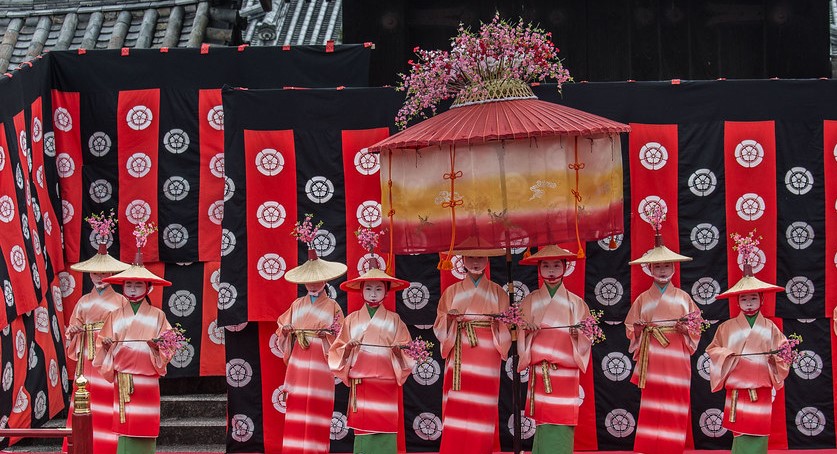
Hinamatsuri Girl’s Day (March 3; all Japan): On this day and on this day only hinamatsuri doll sets are set up in the home for the protection and health of daughters. To experience a sense of these dolls sets just visit and large high-class department store and go up a few floors to the traditional arts display areas. The interview at the bottom of this page (see index) with the Kyoto Katsura doll making family will help you to understand how important dolls were and still are in Japanese society. The doll making process is complex and involves many craftspeople. The Katsura family is well known for its high standards and impeccable work, which has been recognized by the Japanese Imperial Family.Kyoto Higashiyama Hanatoro Festival (early to mid-March; Kyoto): Kyoto has become famous for this large and impressive traditional light and flower illumination event. Thousands of handmade paper lanterns lining the streets just east of the Gion geisha district along with large ikebana flower displays. Don’t miss this event if you are in Kyoto! Omizutori fire ritual (March 12, Nara): During this Buddhist festival in Nara monks burn pine torches and draw water from a well. The annual ritual is held to cleanse people of their sins as the new spring rises. Tsunan Snow Festival (March 14; Niigata): During this snow festival in Tsunan City, Niigata, more than 2,000 sky lanterns are released into the sky at night. Beautiful!!! Omihachiman Sagicho Fire Festival (March 14-15; Shiga prefecture, east of Kyoto): This event celebrates this area’s successes in a float competition that has existed since the late 16th century. Later the floats, made of straw and wood, are set alight and people dance around the flaming floats.
- Japan March travel food highlights
- Japan March travel tree and flower highlights
- Japan March travel festival highlights
- March Equinox & Japanese Graveyards: This world and the next
- March interview: The Katsura Family: Famous doll makers
March Equinox & Japanese Graveyards: This world and the next
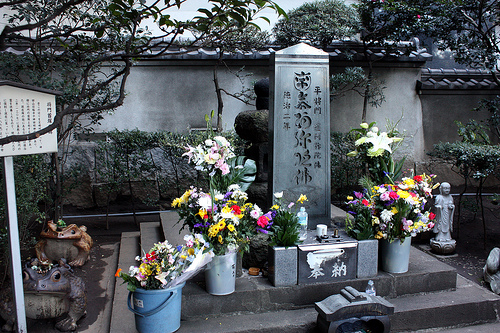
Japanese people follow a tradition called Ohigan (Equinox) in spring around March 20th (and again in September). During Ohigan, they visit their ancestor’s graves and place flowers, small, shiny-dark-green leafed branches, sake/beer, rice crackers, or rice on the gravestone.
Though the visitor may not have personal reasons for going to a Japanese graveyard, chances are that you will stumble across one in your explorations. They are interesting places and you should try to experience at least one: a big one, a great one. In Kyoto, with its many major temples of a wide range of sects, you will see more graveyards than anywhere else. Owing to the fact that Amida Buddhism and its off-shoots played such an important role in the religious development of the city, Kyoto's largest cemeteries are located at the eastern edge of the city. Here they look out across the valley to the west, which is where Amida’s Western Paradise is said to lie. The best ones are: 1) southwest of Kiyomizu Temple; 2) east of Kodai-ji Temple; 3) on the top (southeast area) of Yoshidayama (a vast linked area extending from Shinnyodo Temple in the north to Kurodani Temple to the south).
Japanese graveyard symbolism is for the most part derived from ancient Chinese traditions. For example, many gravestones are divided into three sections. The top one represents heaven, the middle one man or woman, and the third one earth. If we think about this arrangement, then we can said that the living are caught somewhere between heaven and earth.
There are many superstitions regarding gravestones. A grave or a graveyard should never face east or north. As a matter of respect, new graves should never be larger than an earlier ancestor’s grave. A five-part stone tower called a gorinto should also be erected in the far west corner of the plot (not common due to the considerable expense involved). The five levels represent the traditional Buddhist elements: earth, water, fire, wind, and sky. They also serve to remind people of the Buddha's five primary precepts do not kill, steal, drink to excess, lie or commit adultery.
- Japan March travel food highlights
- Japan March travel tree and flower highlights
- Japan March travel festival highlights
- March Equinox & Japanese Graveyards: This world and the next
- March interview: The Katsura Family: Famous doll makers
March interview: The Katsura Family: Famous doll makers
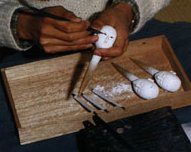
The Katsura family has been creating beautiful hand-crafted hair settings for traditional Japanese dolls for three generations. Most of their work is done for traditional hina-ningyo dolls and doll sets, which are traditionally displayed in Japanese homes on Girl's Day (March 3rd). The doll making process is complex and involves many craftspeople. The Katsura family is well known for its high standards and impeccable work, which has been recognized by both the Imperial Family and Imperial Household Agency.
YJPT: How did you get involved in the doll making process?
Katsura: As a third-generation member of the Katsura family, I guess the question is more how could I not get involved! A close relative of our family in Kameoka began making doll hair settings close to 100 years ago. This household had been selling Japanese dolls since the mid Edo period (1750). Around the turn of the century this family had no heir, and so my grandfather married into the family and took over the business. Now we both sell dolls and do the hair styles. If you look at it this way, you could say that our family has been in the doll business for nearly 250 years. At present, we have three generations actively involved in the tradition. My father is 80, I am 55, and my son is 26. While my son focuses on sales throughout the Kansai region, my father and I spend our working days in this little attic creating the hair styles for traditional Japanese dolls.
YJPT: Are the dolls you specialize in for children to play with?
Katsura: Actually, I think these dolls are a bit too expensive for children to play with. Japanese dolls, for both girls and boys, act as guardian spirits, to protect the child, prevent illness, and provide for the child's happiness. Nowadays there are two times in particular when it is a Japanese custom to display dolls in the home. On Girl's Day and then again on the 5th of May, which is Boy’s Day. Historically, however, dolls were displayed in the home up to 5 times a year, according to a no longer practiced Chinese tradition of dividing the year into 5 season: New Year's on Jan. 1st, Girl's Day on March 3rd, Boy's Day (or Tango-no-seku) on May 5th, the Tanabata Festival on July 7th, and Otsukimi (autumn moon viewing) on September 9th.
YJPT: How much does the average handmade hina-ningyo cost nowadays?
Katsura: Let me tell you a bit about the tradition behind these dolls first. Forty to fifty percent of all Japanese children still receive these dolls during the first years of their life. Girls are usually presented with their guardian dolls in March of their second year. Today, it is generally the grandparents who pay for the doll set, according to the wishes of the parents. Usually they settle on an appropriate selection, which means an affordable set. However, sometimes the price range of the parent's selection is beyond the grandparent's budget. I've heard of some cases where the grandparents have had to make formal visits to other family members to ask for money in order to gather together enough to buy the dolls the parents wanted. Ningyo have traditionally been regarded as a sacred matter to do with the life of the child. However, nowadays the dolls and festivities surrounding them have become more fun than anything else. Because of this, as old Japanese traditions fade away, change or cease to exist all together, we have seen a great decrease in orders.
The average cost for a good doll is 300,000 - 500,000 yen. But in Japan, as you know, tradition is priced according to quality and the name of the artist. Because of this you can easily pay 8 million yen for a single doll, if you wanted to or could afford to. The price difference is reflected in the facial features of the doll, its clothing quality, or other detailed features like this. Some of our orders take three to five years to complete. You also have to remember that dolls come in sets of 10 or 15 and so, generally, a really good set of dolls will cost a family about 3 million yen (~ US$ 25,000).
YJPT: How long does it take to make a single doll?
Katsura: Each part of the doll requires a specialized craft or traditional technique. One family will make the body, another the head, another the clothes, and so on. Our family has always specialized in the hair style or setting for dolls. Generally, depending on the quality required, we can finish about 5 heads in one day. Each separate stage in the application process (scraping out the canal groove along the back of the skull where the hair is affixed, fitting and attaching the hair, etc.) takes time. There is often a lot of time, basically waiting time, between stages. One of the most time consuming parts of the process is waiting for the glue to dry completely.
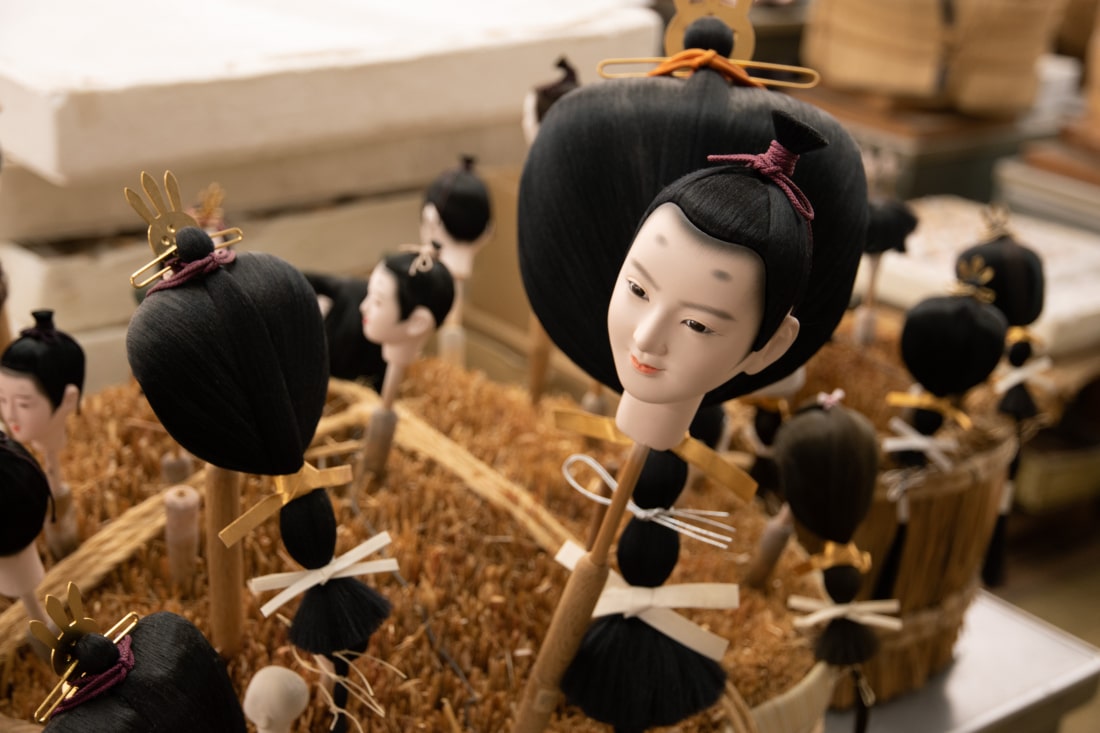
YJPT: What are some of the more important points to keep in mind in the doll making process?
Katsura: Of course using high quality natural materials is essential to the beauty and durability of the finished product. For example, we use only natural glues. One of the main reasons is because we must constantly lick the hair affixing tool so that it won't stick to the hair as we are working with it. If we used artificial, chemical-based glues we would slowly poison ourselves over time. For the final hair setting stage, in particular, we use a seaweed-based glue.
A well crafted head is required to design a hair setting. Doll heads are generally made of compacted cypress powder, powdered shells for the white skin and inlayed glass for the eyes. We must "plant" the hair in such a way that it is divided equally and evenly across the surface of the head, so that when you look at the head it looks perfectly balanced. Nowadays many hair stylists use a cheaper material like rayon for the hair; however, we still insist on hair that is made of hand-dyed silk thread. The difference is obvious. On some occasions we also use real human hair, generally from girls up to 14 years of age.
YJPT: Are you busy year round or just seasonally?
Katsura: We are really busy from early autumn to the New Year, and then, after that, we are extremely busy until Boy's Day on May 5th. For us, the New Year, and the idea of a vacation, only becomes a reality after everyone else's May Golden Week holiday because we usually have to work virtually around the clock from Christmas to May. Twenty or thirty years ago, we used to be busy year-round because of the tradition of presenting dolls at wedding ceremonies. But this tradition has largely faded away, and so we now generally have summers off.
YJPT: Generally, how many kinds of dolls are there?
Katsura: For the dolls that are associated with Doll's Day, there are three basic types, all of which are determined according to hair style. The three hair styles are osuberakashi, fukurakashi, and nagakei. We make all three, and generally any doll set will have all of these hair styles in it.
Japan month by month private travel & culture summary index
Japan spring travel: Mar, April, May. Learn more!
Japan summer travel: June, July, August. Learn more!
Japan autumn travel: Sept, Oct, Nov. Learn more!
Japan winter travel: Dec, Jan, Feb. Learn more!
Content by Ian Martin Ropke, owner of Your Japan Private Tours (est. 1990). I have been planning, designing, and making custom Japan private tours on all five Japanese islands since the early 1990s. I work closely with Japan private tour clients and have worked for all kinds of families, companies, and individuals since 1990. Clients find me mostly via organic search, and I advertise my custom Japan private tours & travel services on www.japan-guide.com, which has the best all-Japan English content & maps in Japan! If you are going to Japan and you understand the advantages of private travel, consider my services for your next trip. And thank you for reading my content. I, Ian Martin Ropke (unique on Google Search), am also a serious nonfiction and fiction writer, a startup founder (NexussPlus.com), and a spiritual wood sculptor. Learn more!